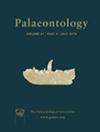Cranial endocast of Anagale gobiensis (Anagalidae) and its implications for early brain evolution in Euarchontoglires
IF 2.3
2区 地球科学
Q1 PALEONTOLOGY
引用次数: 2
Abstract
Anagalids are an extinct group of primitive mammals from the Asian Palaeogene thought to be possible basal members of Glires. Anagalid material is rare, with only a handful of crania known. Here we describe the first virtual endocast of an anagalid, based on the holotype of Anagale gobiensis (AMNH 26079; late Eocene, China), which allows for comparison with published endocasts from fossil members of modern euarchontogliran lineages (i.e. primates, rodents, lagomorphs). The endocast displays traits often observed in fossorial mammals, such as relatively small petrosal lobules and a low neocortical ratio, which would be consistent with previous inferences about use of subterranean food sources based on heavy dental wear. In fact, Anagale gobiensis has the lowest neocortical ratio yet recorded for a euarchontogliran. This species was olfaction‐driven, based on the relatively large olfactory bulbs and laterally expansive palaeocortex. The endocast supports previous inferences that relatively large olfactory bulbs, partial midbrain exposure and low encephalization quotient are ancestral for Euarchontoglires, although the likely fossorial adaptations of Anagale gobiensis may also partly explain these traits. While Anagale gobiensis is a primitive mammal in many aspects, some of its derived endocranial traits point towards a new, different trajectory of brain evolution within Euarchontoglires.圆角鸭(圆角鸭科)的颅骨内嵌及其对原长齿动物早期脑进化的意义
拟兽是亚洲古近纪已灭绝的一种原始哺乳动物,被认为可能是Glires的基础成员。苯胺类物质非常罕见,目前已知的头盖骨屈指可数。在这里,我们描述的第一个虚拟代理的Anagale gobiensis (AMNH 26079;中国晚始新世),这可以与已发表的现代准始祖胶质动物谱系(即灵长类动物、啮齿动物、狐形动物)的化石成员的模型进行比较。内胆显示了在穴居哺乳动物中经常观察到的特征,例如相对较小的岩小叶和较低的新皮质比例,这与先前基于牙齿严重磨损而使用地下食物来源的推断一致。事实上,gobiensis Anagale的新皮质比例是迄今为止记录在案的最低的。这个物种是嗅觉驱动的,基于相对较大的嗅球和外侧扩张的古皮层。这项研究支持了先前的推断,即相对较大的嗅球、部分中脑暴露和低脑化商是原始祖,尽管gobiensis可能的化石适应也可能部分解释了这些特征。虽然gobiensis在许多方面都是一种原始哺乳动物,但其衍生的一些颅内特征指向了一种新的、不同的原始动物大脑进化轨迹。
本文章由计算机程序翻译,如有差异,请以英文原文为准。
求助全文
约1分钟内获得全文
求助全文
来源期刊

Palaeontology
地学-古生物学
CiteScore
5.60
自引率
3.80%
发文量
43
审稿时长
6 months
期刊介绍:
Palaeontology publishes a wide variety of papers on palaeontological topics covering:
palaeozoology
palaeobotany
systematic studies
palaeoecology
micropalaeontology
palaeobiogeography
functional morphology
stratigraphy
taxonomy
taphonomy
palaeoenvironmental reconstruction
palaeoclimate analysis and biomineralization studies.
 求助内容:
求助内容: 应助结果提醒方式:
应助结果提醒方式:


